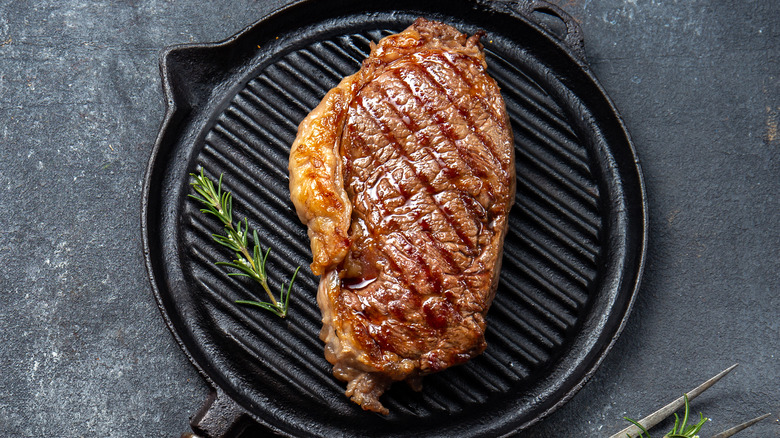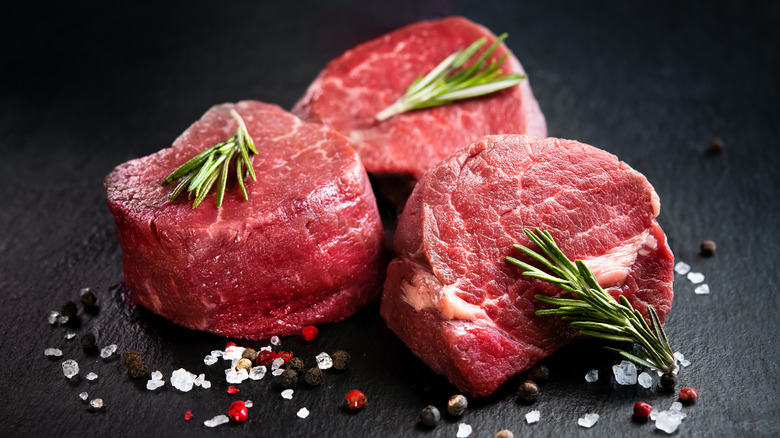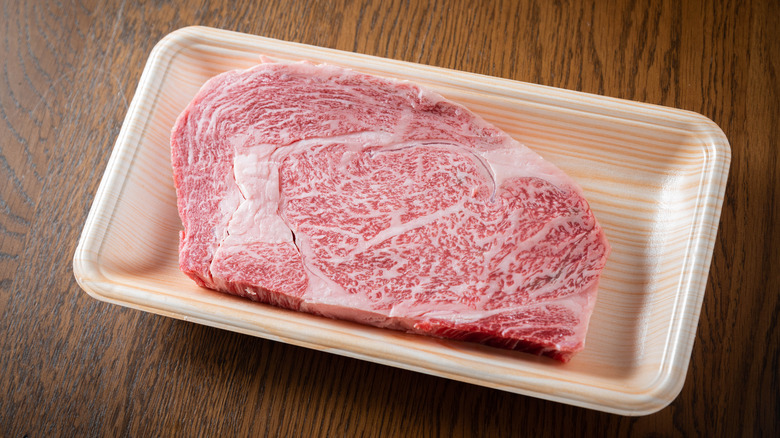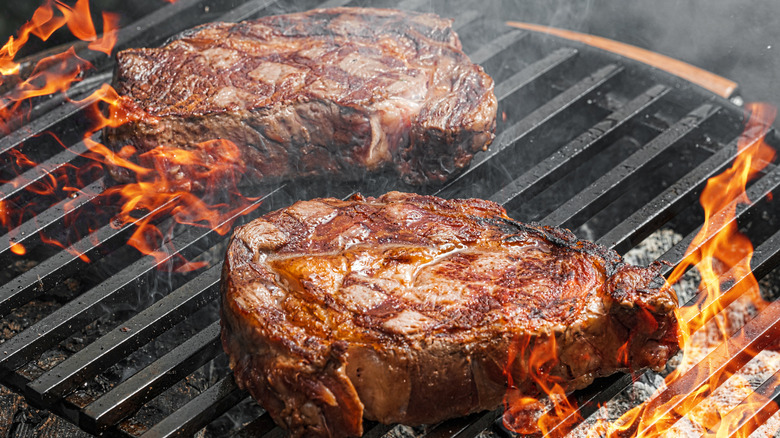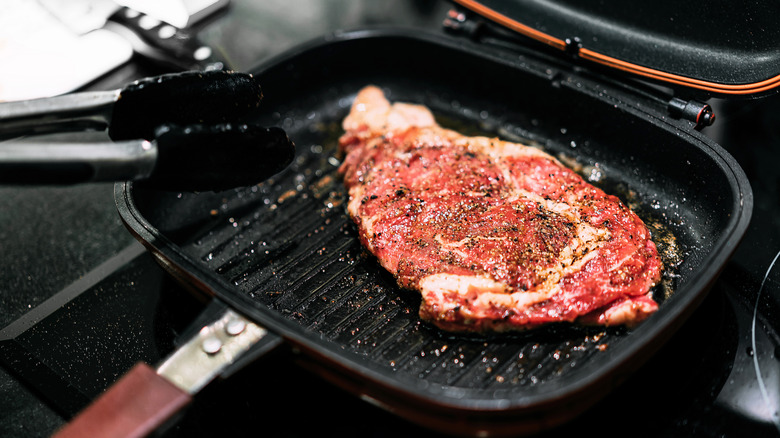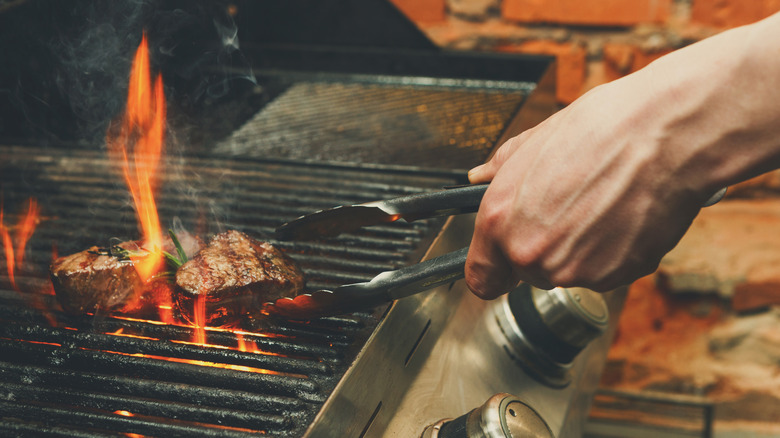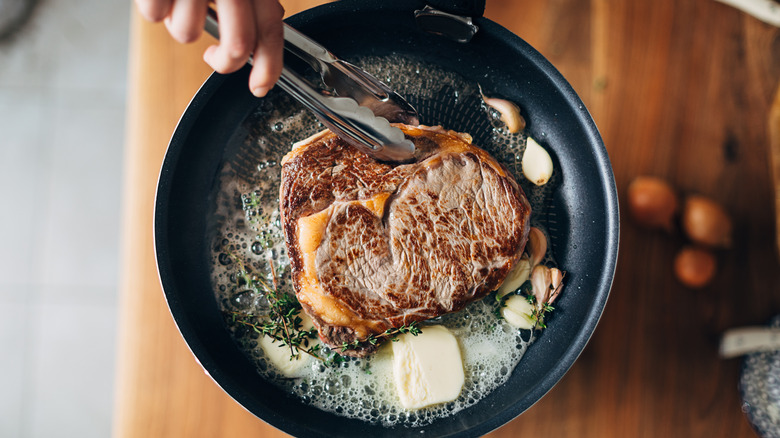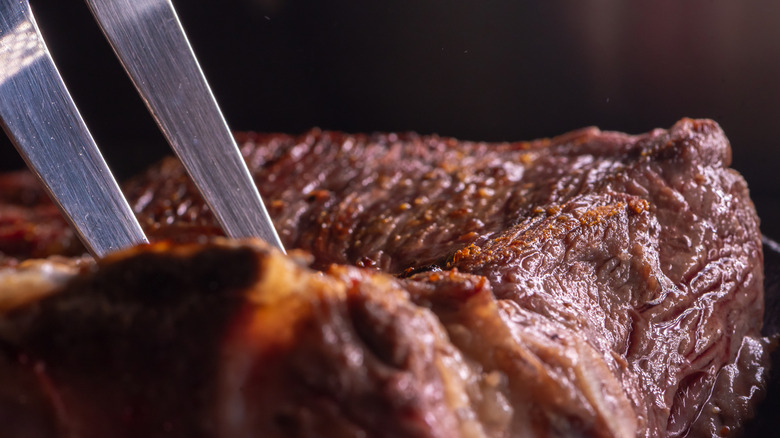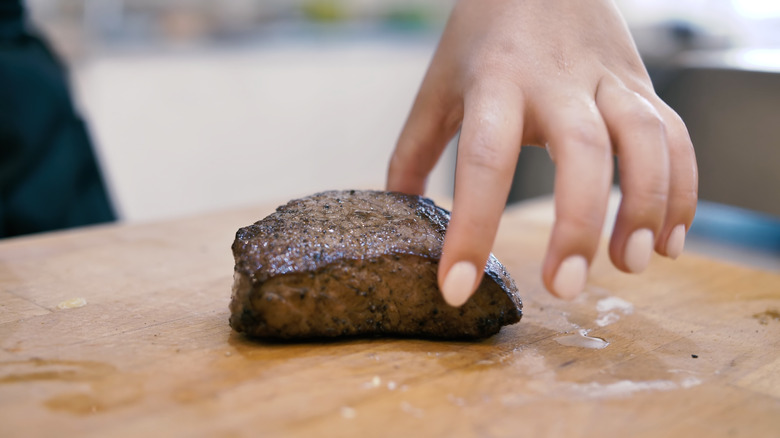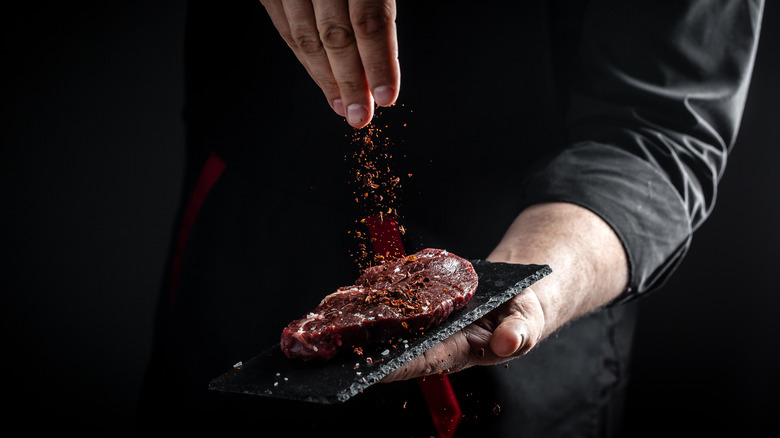Common Myths About Cooking Steak You Need To Know
While the love of beef is widespread across the U.S. (per Insider), with Americans eating five steaks per month on average (as reported by OnePoll via SWNS Digitals), opinions differ on how a steak is best enjoyed. In May 2016, Longhorn Steakhouse conducted a poll across their 491 locations to determine how Americans like their steaks cooked. It turns out that 2.5% prefer their steaks rare, 22.5% opt for medium-rare, 37.5% choose medium, 25.8% order medium-well, and 11.7% enjoy a well-done steak (per Maxim). With such widely differing opinions, it is fair to say that a perfectly cooked steak is a subjective thing.
While the degree of cooking a steak will and always should be up for debate, the way it is cooked should be a practice grounded in facts. Yet, there are many myths surrounding the proper techniques used to produce the best results. Read on as we debunk the most common myths surrounding the process of cooking steaks.
Myth: Filet mignon makes the best steak
As reported by Interfaces, many consumers believe that a high price point indicates that a product is superior to cheaper alternatives. In the culinary world, we most frequently associate this phenomenon with high-end products like wine (per The International Journal of Marketing Studies). However, meat is no different, and this is especially true when it comes to steak. The classic example of this is filet mignon, which is one of the most expensive cuts of beef (via Clover Meadows Beef). This cut is small, lean, and incredibly tender. While this may be desirable for some dishes, a lack of intramuscular fat — known as marbling — means filet mignon can be a tasteless, textureless, and dry, as reported by Thrillist.
In comparison, cheaper, fattier cuts of meat prove far superior in taste and texture. Speaking to Thrillist, chef and owner at Blackbelly Hosea Rosenberg highlighted a cut he greatly prefers. "The Denver is a really amazing and affordable cut," he said. "It's found on the chuck, is well-marbled, and has no connective tissues or fat caps to negotiate. Just delicious, firm steak that can be grilled, roasted, or seared to a perfect medium-rare for about 25% of the cost of a 'premium' cut of steak."
Myth: Steak should be brought up to room temperature before cooking
Perhaps one of the most prolific myths when it comes to cooking steak is the idea that it must be brought to room temperature prior to cooking. This is demonstrated by the number of prominent industry professionals who swear by the practice, such as Alain Ducasse, a French chef with Michelin stars (per Gentleman's Journal). The thought process behind bringing steak up to room temperature is that it will ensure it cooks evenly.
Going against the opinions of such esteemed people in the culinary industry is a daunting prospect. However, a test run by Cook's Illustrated found that steaks taken out of the fridge for one or two hours only experienced minor temperature increases. Furthermore, the steaks were found to have no discernible differences in taste, texture, or appearance when compared to ones cooked straight from the fridge.
It is important to note that meat should not be left at room temperature for more than two hours or one hour if the temperature is above 90 degrees (per United States Department of Agriculture). If meat is left unrefrigerated for too long, there is a chance that dangerous levels of harmful bacteria will build on it.
Myth: The only way to cook a steak is with direct heat
When you think of cooking a steak, you likely picture someone putting a slab of meat on a flaming hot grill or sliding it in a scorching skillet. While these traditional methods are perfectly suitable ways to cook steak, they are not necessarily the best.
Sous vide is a cooking technique that involves vacuum packing food before submerging it in warm water for long periods. This method of cooking does not use a direct heat source and results in a perfectly cooked steak. Sous vide works because the water's ambient heat slowly brings the entire cut of meat up to temperature without overcooking the edges (per Men's Journal). However, when cooking steak with indirect heat sources, it is important to sear it in a hot pan before serving. As reported by Anova, this not only makes the steak look more appealing but also creates vital flavor and textural contrast between the edge of the steak and its interior.
Myth: A steak must be seared to lock in its juices
Searing is an important step when it comes to cooking a steak as it creates a brown, textured crust. However, this process is also the source of another popular gastronomic myth, which is that searing is the only way to lock in the meat's juices (per The Guardian). This notion is false, as demonstrated by a study published in the Journal of Culinary Science and Technology, which found searing to have no effect on a steak's moisture retention.
A better way to lock in the meat's juices is to reverse sear it. With this method, the meat is baked in the oven and then seared in a pan on the stove (per Masterclass). This approach ensures even, gentle cooking takes place, which minimizes the loss of moisture, as reported by Primer Magazine. In an interview with the publication, chef and restaurateur David Gaus explained that "a lot of professional kitchens have switched to reverse searing because they're seeing a more consistent product."
Myth: A steak should only be flipped once
Many people are misled into thinking that once the steak is put on the grill or in the skillet it should only be flipped once to prevent moisture loss and create the perfect crust. While this technique may produce aesthetically pleasing grill marks, it's not the best strategy when cooking steak.
Author and food columnist J. Kenji López-Alt reports that flipping steak "every 30 seconds or so" is a far superior technique that results in "a crust that is just as good." Chef Heston Blumenthal agrees with the concept of more frequent flipping as he noted in an interview with PerthNow. "This is the key thing: flip your steak every 10-15 seconds," he said. "Traditionally, you do two minutes on one side, two minutes on the other and you get a nice brown bit of steak [...] But if you like a nice crust on the outside and for it to be pink in the middle, just keep flipping it."
Myth: Basting with butter is best
Pan basting is a technique that uses melted fat to impart flavor and contribute to the cooking process (per Hestan Cue). Generally speaking, butter is the fat used most often to baste steak. However, butter is not the most flavorful form of fat available, and there is a growing consensus that animal fat, such as lard or drippings, should be used to baste meat instead.
Beef drippings are created when the fat melts off the meat during the cooking process. The drippings are collected and cooled until they attain a solid, butter-like consistency (per The Telegraph). When searing a steak, the beef drippings can be used to baste it, which imparts huge amounts of flavor into the meat. Additionally, if steak is cooked using the reverse sear method, drippings can be collected from the pan during the oven roasting process and used to baste it.
Myth: Don't pierce steak when cooking
When it comes to properly cooking steak, there is a focus on minimizing moisture loss throughout the process. However, some of the ways we seek to minimize a steak's moisture loss are misguided. A prime example of this is that piercing any type of hole in the meat will allow all of the juices to leak out and leave the steak dry.
So widespread is this misconception that Cook's Illustrated conducted an experiment to test the theory. While cooking two steaks, they flipped one with tongs and the other one by piercing it with a fork. They then weighed the steaks and found that the meat had the same moisture content. The publication concluded that piercing the meat does not damage fibers enough to force the juices out. "When it comes to the moisture level and tenderness of meat, cooking time and temperature are the most important factors," the outlet explained.
Myth: The poke test will tell you when the steak is done
The poke test is many home cooks' favorite trick. It involves comparing the firmness of a cooked steak to the fleshy part of your thumb to determine the level of doneness.
The idea behind this method is that the firmness of the fleshy part of your thumb resembles a rare steak when the hand is relaxed, a medium steak when the thumb and forefinger touch, and so on as you progress through your fingers (per Healthline).
Unfortunately for those who love the simple nature of this method, a study published in The Medical Journal of Australia found that the accuracy of this technique was low. The participants only categorized the steak correctly 36% of the time, although it should be noted that the study was performed on amateur cooks, and thus, the accuracy of this technique may differ for professionals.
With cheap and accurate meat thermometers widely available, there is no need for guesstimates to be made via the unreliable poke test. Rather, the internal temperature should be taken and the result compared to temperature guides (per Oxo).
Myth: Only season a steak after cooking
The right time to season a steak is a point of contention and has divided many chefs (per The Pioneer Woman). However, the idea that steak should only be seasoned after it's finished cooking is a misguided one that can negatively affect the meat.
Salt not only flavors steak but also contributes to the development of a browned crust. Excess moisture on the surface of the meat leads to evaporation occurring when it comes into contact with the pan. This prevents the Maillard reaction from taking place and can ruin the searing process (per Modernist Cuisine).
Salting a steak and allowing it to rest before cooking — a method known as dry brining — helps to dry the exterior of the meat. Through the process of osmosis, the salt draws moisture out of the beef. This liquid is then reabsorbed, sucking all the moisture back into the fibers and leaving the crust noticeably drier (per McCormick). This process also allows the steak to retain more moisture while cooking, as Max Grebb, a renowned chef and food blogger, explains in an interview with McCormick. "When you're dry brining a steak," he explains, "all that salt that has been fully absorbed by the meat itself binds to those molecules, making it harder for water to escape and ultimately improving moisture retention within those cells."
